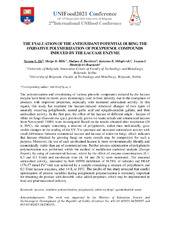Prikaz osnovnih podataka o dokumentu
The evaluation of the antioxidant potential during the oxidative polymerization of polyphenol compounds induced by laccase enzyme
| dc.creator | Ilić, Nevena | |
| dc.creator | Milić, Marija | |
| dc.creator | Davidović, Slađana | |
| dc.creator | Mihajlovski, Katarina | |
| dc.creator | Dimitrijević-Branković, Suzana | |
| dc.date.accessioned | 2023-03-01T08:18:13Z | |
| dc.date.available | 2023-03-01T08:18:13Z | |
| dc.date.issued | 2021 | |
| dc.identifier.isbn | 978-86-7522-066-4 | |
| dc.identifier.uri | http://TechnoRep.tmf.bg.ac.rs/handle/123456789/5939 | |
| dc.description.abstract | The polymerization and crosslinking of various phenolic compounds induced by the laccase enzyme have been in recent years increasingly used in food industry, due to the emergence of products with improved properties, especially with increased antioxidant activity. In this regard, this study has explored the laccase-induced structural changes of two types of naturally occurring polyphenols, named gallic acid and epigallocatechin gallate, and their antioxidant activity. In the first part, the effect of the laccase of different origin - laccase of white rot fungi (Ganoderma spp.), previously grown on waste cereals and commercial laccase from Novozym® 51003, were investigated. Based on the results obtained after incubation (24 h, 50ºC), the sample containing a mixture of polyphenols, rather than individually, gave visible changes in the reading of the UV-Vis spectrum and increased antioxidant activity with small differences between commercial laccase and laccase of white rot fungi, which indicates that laccase obtained by growing fungi on waste cereals may be competitive for such a purpose. Moreover, the use of such an obtained laccase is more environmentally friendly and economically viable than use of commercial one. Further process optimization of polyphenols polymerization was performed within the method of multifactor statistical analysis (Design Expert), by using of commercial laccase, where by the effect of enzyme concentrations (0.1, 0.3 and 0.5 U/ml) and incubation time (4, 14 and 24 h) were monitored. The maximal antioxidant activity, measured by both DPPH (inhibition of 58.58% of radicals) and FRAP (176.57 mmol Fe2+/ml) was achieved by a sample containing a mixture of polyphenols and 0.3 U/ml laccase enzymes, after 14 h, at 50˚C. The results of this study revealed that careful optimization of process variables during polyphenols polymerization is extremely important for obtaining the product with desirable value added properties, which may be implemented in food and pharmaceutical industry. | sr |
| dc.language.iso | en | sr |
| dc.relation | info:eu-repo/grantAgreement/MESTD/inst-2020/200287/RS// | sr |
| dc.relation | info:eu-repo/grantAgreement/MESTD/inst-2020/200135/RS// | sr |
| dc.rights | openAccess | sr |
| dc.rights.uri | https://creativecommons.org/licenses/by/4.0/ | |
| dc.source | Book of Abstracts, The 2nd Unifood International Conference-UNIFood Conference 2021 | sr |
| dc.subject | laccase, oxidative polymerization, polyphenols, white rot fungi, agroindustrial waste | sr |
| dc.title | The evaluation of the antioxidant potential during the oxidative polymerization of polyphenol compounds induced by laccase enzyme | sr |
| dc.type | conferenceObject | sr |
| dc.rights.license | BY | sr |
| dc.citation.spage | 158 | |
| dc.identifier.fulltext | http://TechnoRep.tmf.bg.ac.rs/bitstream/id/15728/bitstream_15728.pdf | |
| dc.identifier.rcub | https://hdl.handle.net/21.15107/rcub_technorep_5939 | |
| dc.type.version | publishedVersion | sr |

